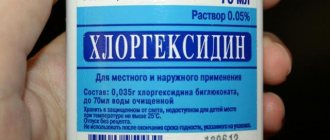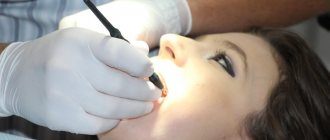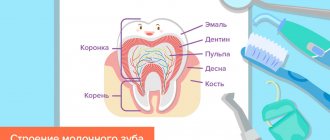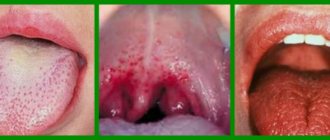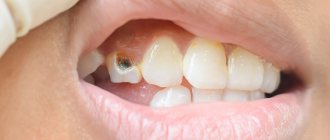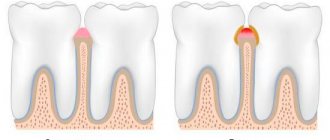Author of the article:
Soldatova Lyudmila Nikolaevna
Candidate of Medical Sciences, Professor of the Department of Clinical Dentistry of the St. Petersburg Medical and Social Institute, Chief Physician of the Alfa-Dent Dental Clinic, St. Petersburg
More than 300 varieties of microorganisms live in the oral cavity (streptococci, lactobacilli, fungi of the genus Candida, staphylococci, etc.), which make up its microflora, or microbiota. Constant humidity, optimal temperature and pH values, the presence of food residues - all this creates favorable conditions for the proliferation of various types of microbes.
The composition of the oral microbiota is individual for each person, so the concept of “normal microflora” is also individual. Many opportunistic microorganisms that make up the normal microflora of the oral cavity play an important role in the etiology and pathogenesis of caries, diseases of the mucous membrane and periodontal tissue. The microbiota of the oral cavity is involved in the primary processes of food digestion and absorption of nutrients, in the synthesis of vitamins, and in maintaining the proper functioning of the immune system.
The qualitative and quantitative composition of microflora usually changes little throughout a person’s life, but under certain factors this is possible. In this case, they speak of an imbalance of microflora, that is, dysbacteriosis, when the proportion of normal microflora decreases, and the growth of pathogenic microorganisms increases.
The ailment itself, designated by the term “dysbacteriosis,” is not a disease and is not included in the official international classifications of diseases. It should be considered as a set of symptoms indicating the presence of pathological processes in various body systems. Occurs in adults and children. Let's talk about oral dysbiosis: how it manifests itself, why it is dangerous, how to treat it.
Stages of development of dysbiosis in the oral cavity
Some researchers identify several stages in the formation of oral dysbiosis:
- Stage 1 - dysbiotic shift (compensated dysbiosis). Characterized by an increase in the number of one type or several types of pathogenic microorganisms in the oral cavity. At this stage there are no manifestations;
- Stage 2 - subcompensated dysbacteriosis. There are fewer lactobacilli, and barely noticeable manifestations appear;
- Stage 3. The lactobacilli needed by the body are replaced by pathogenic microorganisms;
- Stage 4. Yeast-like fungi begin to actively multiply in an unnatural niche for them.
At stages 3 and 4 (decompensated dysbacteriosis), inflammatory elements, ulcers, and excessive keratinization of the oral epithelium may occur.
All this can lead to the development of stomatitis, periodontitis, and periodontal disease. An infection of the nasopharynx may occur.
How do you know when it’s time to restore the microflora?
Untimely treatment of dysbiosis can lead to tooth loss. Therefore, at the slightest sign of disease, it is important to consult a dentist as soon as possible. Based on an examination of the oral cavity and test results, the doctor will prescribe effective treatment for the pathology and, if necessary, recommend probiotics and lactobacilli for the oral cavity.
Dentists divide dysbiosis into several stages:
- Dysbiotic shift is a mild increase in the number of one of the types of opportunistic microorganisms. The general composition of the microflora does not change.
- Subcompensated dysbacteriosis. The number of beneficial microorganisms decreases slightly against the background of increased activity of opportunistic bacteria.
- Monoculture, in which beneficial microorganisms are replaced by a pathogenic monoculture, and lactobacilli in the oral cavity are absent or remain in the form of traces.
- Decompensated, in which the microflora is populated by associations of pathogenic bacteria, as well as yeast-like fungi.
At the initial stage, dysbiosis manifests itself in the form of sticking in the corners of the mouth and an unpleasant odor. At later stages of development, the disease manifests itself with symptoms such as:
- dry mouth;
- coating on the tongue;
- tartar;
- unpleasant taste in the mouth;
- point inflammation on the gums;
- bad breath;
- plaque;
- compaction and blisters on the mucous membrane;
- regular inflammation of the tonsils.
Symptoms of oral dysbiosis
Symptoms designated by the term “oral dysbiosis” occur in many different diseases and syndromes, so the disease is difficult to diagnose. Let's name the signs of an imbalance in the oral microflora:
- bad breath (halitosis);
- metallic taste, burning sensation in the mouth;
- the development of candidiasis, or thrush - a white coating on the tongue and mucous membranes of the cheeks;
- inflammation of the mucous membranes and gums;
- swelling, redness and soreness of the tongue;
- The appearance of so-called jams in the corners of the mouth is characteristic.
The pathology of normal microflora in the mouth is fraught with the danger of endogenous infections.
The listed manifestations are due to the following changes:
- colonization resistance (local immunity) of the mucous membrane is disrupted - yeast-like fungi easily adhere to the surface of the epithelium, where there are optimal conditions for reproduction;
- the bacterial antagonism of normal microflora changes significantly - normally, antagonistic microbes do not allow pathogenic fungi to actively multiply, but with dysbiosis, the former are destroyed, which provokes rapid proliferation of Candida fungi;
- In patients, a significant shift in local protective factors is detected - the weakened defense does not cope with its function, so the volume of pathogenic microflora increases unhindered.
Gastritis (gastroduodenitis)
This is one of the most common gastrointestinal pathologies, often occurring in both adults and children. With gastritis, due to changes in secretion, the acidity of gastric juice increases, and since all organs of the digestive system are directly connected to each other, such acidity cannot but affect the health of the oral cavity.
Dental symptoms of this disease include pallor and swelling of the mucous membranes, hypertrophy of the tongue papillae, dry lips, gingivitis, bad breath and sour taste.
Chronic gastroduodenitis is characterized by mild forms of stomatitis and gingivitis.
, herpes on the lips.
In both cases, disturbances in the production of saliva occur, which most directly affects the acid-base balance of the oral cavity and the intensity of bacterial growth: with a lack of saliva, the risk of carious and periodontal diseases
.
Treatment:
as a rule, individual, aimed at normalizing gastric secretion, increasing the protective properties of the mucous membrane of the stomach and oral cavity.
Dental treatment may include taking a course of antibiotic drugs (as recommended by a doctor), treatment of gingivitis and caries
, enhanced
oral hygiene
using special toothpastes to strengthen the gums and
professional oral hygiene
performed at least once every six months.
Reasons for the formation of oral dysbiosis
The reasons that lead to disturbances in microbiocenosis in the mouth are, for the most part, the same as for dysbacteriosis in other areas of the gastrointestinal tract. These include:
- prolonged and uncontrolled use of antibiotics;
- use of antibacterial and antiseptic agents for mouth rinsing. Long-term use of bactericidal rinses, antimicrobial toothpastes, and local antiseptics like chlorhexidine leads to the destruction of not only harmful, but also beneficial bacteria in the oral cavity. At the same time, the resistance of pathogenic flora to antibiotics increases;
- infectious and inflammatory diseases, intoxication and weakening of the macroorganism against their background;
- hypovitaminosis - lack of vitamins.
Often the cause of dysbiosis in the mouth is incorrect or insufficient oral hygiene. A factor that provokes a violation of the microflora of the oral cavity is smoking.
How to fight bacteria in the mouth
Does the thought of oral bacteria living on your teeth make you nervous? And for good reason! Harmful microorganisms in the mouth can form plaque, a buildup that sticks to the teeth and gums. If not removed by brushing, toothpaste and flossing, it can lead to cavities and sore gums! Find out how you can reduce the number of harmful bacteria in your mouth.
Regular teeth cleaning
Brushing your teeth is a powerful tool for combating bacterial buildup on your teeth. Use fluoride toothpaste at least twice a day: after breakfast and before bed. You can brush your teeth more often after every meal to reduce plaque buildup and freshen your breath. Gently brush all surfaces of your teeth and tongue for two minutes. Choose a toothpaste designed to keep your mouth clean and fight bacteria.
Germs can also grow on your toothbrush. It is recommended to change it every three months or more often if the bristles are already worn out, as well as immediately after suffering from acute respiratory viral infection. It is best to leave the brush to dry outdoors, as a closed and humid environment promotes the growth of bacteria. Also, you shouldn't share your brush with other people - this way you are exchanging bacteria.
Don't forget about dental floss
Daily flossing is another important point in keeping your mouth clean and healthy. It allows you to fight plaque in places that are hard to reach with a brush. Clean the interdental spaces and subgingival area of each tooth, removing plaque and food debris.
Nutrition and oral bacteria
Your diet can also help maintain a healthy smile. Eating large amounts of foods high in sugar and starch leads to the spread of bacteria in the mouth. Try reducing the amount of sweets in your diet and replacing them with fresh fruits and vegetables. When consuming grains, you should choose whole grains.
Take care of your teeth by brushing, toothpaste, and flossing daily. Eat a balanced diet and visit your dentist regularly. He or she will check your mouth for signs of tooth decay and gum disease, and your dental hygienist will also give you a professional teeth cleaning to remove plaque and tartar (hardened plaque). If you maintain proper oral hygiene, bacteria will have no chance!
Influence of the state of the oral microflora on other organs and systems
The connection between the general condition of the body and dental health is known. Thus, those patients who have oral diseases are more likely to develop cardiovascular diseases. Clinical studies confirm the presence of oral bacterial microflora in the blood and atherosclerotic plaques. Periodontopathogenic microflora is the main source of local and systemic chronic inflammatory process. Acts as a risk factor for the development of coronary heart disease.
In addition, scientists have discovered a connection between bacteria living in the mouth and the occurrence of migraines.
Another dangerous consequence of disruption of the oral microflora is the aggravation of intestinal and esophageal cancer. One study found that bacteria living in the mouth can trigger the development of colon cancer.
Diagnosis and treatment of oral dysbiosis
Oral cavity dysbiosis syndrome in the initial stages of development is detected during laboratory tests. To diagnose oral dysbiosis, microbiological examination of a smear from the oral mucosa or saliva is used. When diagnosing, the number of opportunistic microorganisms in the test material is determined.
Important: it is necessary to accurately establish the root cause of the disease, which a comprehensive examination of the body will help with, and treat the primary disease.
For pathologies of the gastrointestinal tract that affect the condition of the oral cavity, they are first treated.
If the balance of the oral microflora is disturbed, treatment is mainly used in the form of sanitation and taking medications to normalize the microflora in the mouth. However, all drugs that are used to treat oral dysbiosis are considered drugs with unproven effectiveness. The following is used as therapy for this condition:
- eubiotics - needed to increase the number of beneficial bacteria in the mouth;
- immunomodulators - increase local immunity and prevent the growth of pathogenic microorganisms;
- antimicrobial and antifungal agents.
Microflora of the oral cavity
The human oral cavity is a unique ecological system. The permanent microflora in the mouth is formed by hundreds of different organisms; a moist, relatively warm environment creates favorable conditions for their reproduction.
The following play a significant role in the composition of the normal microflora of the oral cavity:
- veillonella, which neutralize acidic foods;
- bacteria of the genera Propionibacterium, Corynebacterium and Eubacterium, producing molecular oxygen;
- lactobacilli;
- rod-shaped lactobacilli - producers of lactic acid;
- bifidobacteria, necessary for the fermentation of carbohydrates and the production of B vitamins and others.
It is difficult to overestimate the importance of healthy oral microflora for the body. It is in this environment that the primary process of food digestion occurs, and therefore the absorption of vitamins and nutrients. Normal microflora is necessary for the proper functioning of the immune system and protecting the body from various fungal, bacterial and viral infections.
With the uncontrolled proliferation of opportunistic microflora and an imbalance of bacteria in the oral mucosa, oral dysbiosis occurs, an extremely unpleasant disease that provokes damage to tooth enamel and gums and can lead to extremely serious consequences for the entire body.
Prevention of dysbiosis in the mouth
Prevention of oral dysbiosis includes the following measures:
- use of antibiotics only as prescribed by a doctor in the recommended course;
- use of alcohol-free and antiseptic rinses for daily oral hygiene, for example, ASEPTA Parodontal Fresh with plant extracts and microelements;
- smoking cessation: it is advisable to eliminate smoking altogether;
- strengthening local immunity: timely sanitation of the oral cavity, maintaining oral hygiene. You also need to strengthen your general immunity.
The main advice for normalizing the microflora of the oral cavity: do not feed the bad microbiota and do not destroy the good one.
Let's summarize: we have given a definition of oral dysbiosis, which is understood as a violation of the ratio between normal and pathogenic microflora in the direction of increasing the latter. They indicated that this condition is not an independent disease, but only a complex of symptoms. The stages of formation of oral dysbiosis, symptoms and causes of disturbances in the microflora of the oral cavity were named. Also from this article you learned how to treat oral dysbiosis and how to prevent its occurrence.
Experts' opinion
Asept products have proven effectiveness. For example, multiple clinical studies have proven that the two-component mouth rinse ASEPTA ACTIVE more effectively combats the causes of inflammation and bleeding compared to single-component rinses - it reduces inflammation by 41% and reduces bleeding gums by 43%.
Sources:
- The role of anti-inflammatory rinse in the treatment of periodontal diseases (L.Yu. Orekhova, A.A. Leontyev, S.B. Ulitovsky) L.Yu. OREKHOVA, Doctor of Medical Sciences, Prof., Head of Department; A.A. LEONTIEV, dentist; S.B. ULITOVSKY, Doctor of Medical Sciences, Prof. Department of Therapeutic Dentistry of St. Petersburg State Medical University named after. acad. I. P. Pavlova
- Report on clinical trials to determine/confirm the preventive properties of commercially produced personal oral hygiene products: mouth rinse "ASEPTA PARODONTAL" - Solution for irrigator." Doctor of Medical Sciences Professor, Honored Doctor of the Russian Federation, Head. Department of Preventive Dentistry S.B. Ulitovsky, doctor-researcher A.A. Leontiev First St. Petersburg State Medical University named after academician I.P. Pavlova, Department of Preventive Dentistry.
- Report on determining/confirming the preventive properties of commercially produced personal oral hygiene products: Asepta toothpaste used in combination with Asepta mouthwash and Asepta gum balm Head. Department of PFS Doctor of Medical Sciences Professor S.B. Ulitovsky St. Petersburg State Medical University named after Academician I.P. Pavlova. Faculty of Dentistry. Department of Preventive Dentistry.

